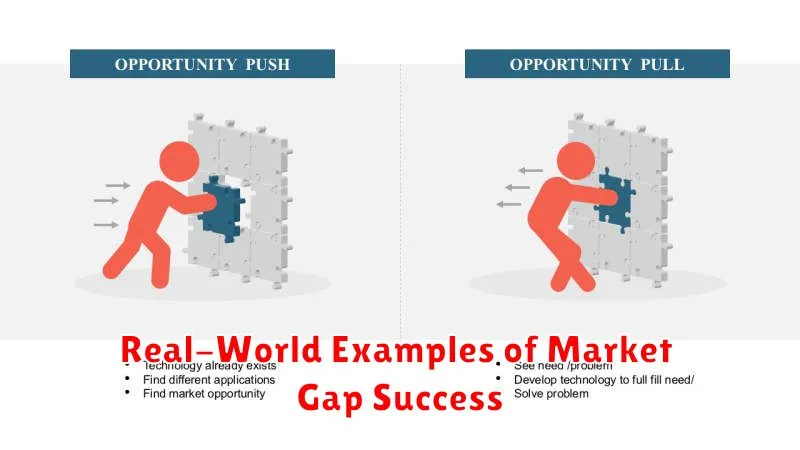In today’s competitive business landscape, identifying and exploiting market gaps is crucial for success. A market gap represents an unmet consumer need or a demand that is not being adequately addressed by existing businesses. Recognizing these market gaps can lead to significant opportunities for entrepreneurs and established companies alike. This article will provide a comprehensive guide on how to identify and effectively exploit these market gaps, turning them into profitable ventures. We will delve into proven strategies, analytical tools, and real-world examples to equip you with the knowledge and skills necessary to capitalize on untapped market potential.
Understanding the dynamics of market gaps is the first step towards harnessing their potential. This involves meticulous market research, analysis of consumer behavior, and a keen awareness of industry trends. By thoroughly examining the existing market landscape, you can pinpoint areas where demand surpasses supply or where current offerings fall short of consumer expectations. This article will empower you to identify different types of market gaps, including those based on product features, demographics, geographic location, and pricing. Through a systematic approach, you can uncover valuable opportunities to introduce innovative products, services, or business models that cater to these unmet needs and gain a competitive edge in the market.
What Is a Market Gap?
A market gap represents an unmet consumer need or a demand that is not being adequately addressed by existing businesses. It’s essentially a void in the market where customers are actively seeking a product or service, but are unable to find a satisfactory solution.
Identifying a market gap can be a lucrative opportunity for businesses. By offering a product or service that fills this gap, companies can capture a significant market share and establish a competitive advantage.
Using Data to Spot Untapped Demand
Data analysis plays a crucial role in identifying untapped market demand. By examining various data sources, businesses can uncover hidden opportunities.
Market research reports provide valuable insights into consumer behavior, preferences, and emerging trends. Analyzing this data can reveal unmet needs and potential market gaps.
Social media listening offers a real-time view of customer conversations and pain points. Tracking keywords and sentiment can highlight areas where current products and services fall short.
Sales data from your own business, including product returns and customer feedback, can indicate areas for improvement and potential new offerings.
By combining these data sources and applying analytical techniques, businesses can gain a clearer understanding of untapped demand and develop strategies to effectively address it.
Listening to Customer Frustrations
A crucial aspect of identifying market gaps involves actively listening to customer frustrations. Unmet needs and pain points often manifest as complaints and negative feedback. By paying close attention to these expressions of dissatisfaction, businesses can uncover valuable insights.
Gathering this information can take various forms. Surveys, focus groups, and social media monitoring are effective methods for collecting customer feedback. Analyzing online reviews and customer support interactions can also reveal recurring issues and areas for improvement.
Look for patterns and common themes in customer complaints. These recurring frustrations often point directly to market gaps where customer needs are not being adequately addressed. This information provides a foundation for developing innovative solutions that directly target those unmet needs.
Analyzing Competitor Weaknesses

A crucial step in identifying market gaps involves thoroughly analyzing competitor weaknesses. This allows you to pinpoint areas where your business can excel and offer superior value to customers.
Start by identifying your key competitors. Examine their product offerings, marketing strategies, and customer service. Look for areas where they are underperforming or failing to meet customer needs. This could include aspects like pricing, product features, distribution channels, or brand perception.
Common weaknesses to look for include outdated technology, poor customer service, limited product selection, slow delivery times, and ineffective marketing campaigns.
Testing with MVPs and Prototypes
A crucial step in exploiting market gaps is rigorous testing. This involves developing Minimum Viable Products (MVPs) and prototypes to gather real-world feedback.
An MVP is a stripped-down version of your product with just enough features to attract early-adopter customers and validate your core assumptions. This allows you to learn what works, what doesn’t, and iterate quickly based on user feedback. Prototypes, on the other hand, can range from low-fidelity mockups to more interactive representations, focusing primarily on the user experience and interface design.
Testing with MVPs and prototypes minimizes development costs and risks by identifying potential problems early on. This iterative process of testing, learning, and refining ultimately leads to a more market-fit product that effectively addresses the identified gap.
Speed and Agility as a Competitive Edge
In today’s dynamic market, speed and agility are no longer just desirable traits; they are essential for survival and success. Companies that can quickly adapt to changing market conditions, customer demands, and emerging technologies gain a significant competitive edge.
Speed refers to the ability to execute quickly, bringing new products and services to market faster than competitors. This rapid response allows businesses to capitalize on emerging opportunities and seize market share.
Agility, on the other hand, is the ability to pivot and adjust strategies as needed. This flexibility allows companies to navigate unforeseen challenges, adapt to evolving customer preferences, and stay ahead of the curve.
Niche Marketing Strategies
Once a market gap has been identified, implementing the right niche marketing strategies is crucial. This involves focusing marketing efforts on a specific, well-defined segment of the market. Concentrated marketing targets a single niche, putting all resources into capturing that segment. Differentiated marketing targets multiple niches, requiring a unique marketing mix for each.
Key to success is understanding your niche audience’s specific needs and desires. This allows for tailored messaging and product development that resonates deeply with the target group. A deep understanding also enables businesses to effectively position their products and services as solutions to specific problems or pain points. This fosters strong brand loyalty and a sustainable competitive advantage within the niche.
Scaling After Validation
Once your product or service has been validated, the next crucial step is scaling. This involves expanding your operations to meet increasing demand. Strategic scaling is vital to capitalize on the identified market gap and achieve sustainable growth. A hasty approach can deplete resources, while a slow approach risks losing momentum and market share.
Begin by analyzing your current capacity and identifying bottlenecks. These limitations could be related to production, staffing, technology, or marketing. Addressing these bottlenecks is essential for smooth scaling. Next, develop a phased approach to expansion. This allows for controlled growth and minimizes risk. Continuously monitor key metrics like customer acquisition cost, conversion rates, and customer lifetime value to ensure the scaling process remains efficient and profitable.
Monitoring Industry Shifts
Staying competitive requires vigilance in identifying industry shifts. These shifts can create significant market gaps, offering opportunities for innovative businesses. Monitoring these changes is a continuous process, demanding attention to several key areas.
Technological advancements often disrupt existing industries. New technologies can create entirely new markets or render existing products and services obsolete. A proactive approach involves tracking emerging technologies and assessing their potential impact.
Regulatory changes can also significantly reshape an industry. New laws and regulations can create barriers to entry or open up new possibilities. Closely monitoring legislative developments and anticipating their consequences is crucial.
Consumer preferences are constantly evolving. Understanding these shifts is essential for identifying unmet needs and adapting offerings accordingly. Market research and trend analysis provide valuable insights into consumer behavior and emerging demands.
Real-World Examples of Market Gap Success

Identifying and exploiting a market gap can lead to significant business success. Here are a few examples:
Netflix: Prior to Netflix, renting movies often involved brick-and-mortar stores with late fees. Netflix capitalized on the gap in convenient, on-demand entertainment, initially with DVDs by mail, and later dominating the streaming market.
Spanx: Sara Blakely identified a gap in the shapewear market for comfortable and invisible undergarments. Her creation of Spanx addressed this unmet need and created a highly successful brand.
Dollar Shave Club: This company disrupted the overpriced razor market by offering a subscription service delivering high-quality razors at a significantly lower cost, directly addressing a price-sensitive market segment.

